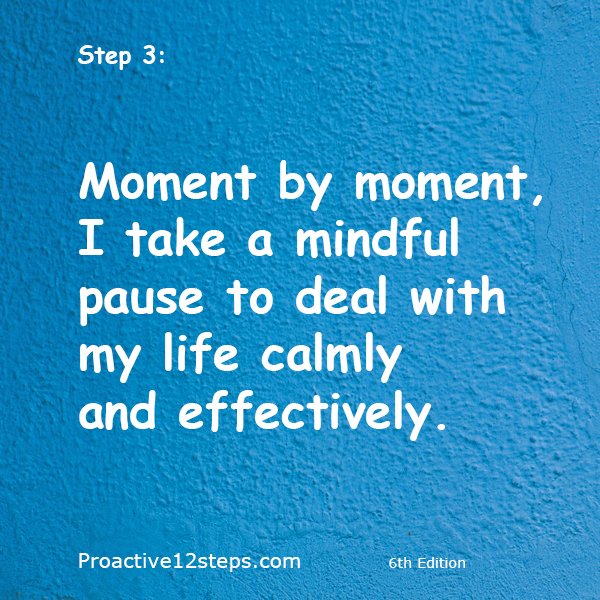
Moment by moment, I take a mindful pause to deal with my life calmly and effectively.
Discussion of Step 3:
Step 2 invited you to slow things down and find patience. It is tough to do so when the stakes are high. So, how do you do it?
Keep in mind the visual metaphor of disentangling a cord. It involves making space between the intertwined strands. How do you do this in real life, with intense situations that seem to require immediate action?
Two components
I suggest you think of any situation as having two components. There is the situation itself, and there is what it triggers in you. If you separate these two strands, you create more space for yourself.
I know the above paragraph is probably feeling very abstract. I want to give you a concrete example. Let’s say you are playing baseball, getting ready to hit the ball with your bat as it is rapidly approaching. This is the first component, the situation itself.
Now, what is the second component? If you are calm as you see the ball approaching, you are best able to hit it at the right time and the right way. If you panic as you see it coming, you’re not.
Even professional baseball players can go through bad streaks. They lose their ability to perform up to their usual standards. Same for golfers and tennis players. It’s not just the situation itself, dealing with the ball. It is what the situation triggers at that time. Even highly talented and highly-trained professionals can crumble under pressure.
Dealing with pressure
So, it is essential to keep in mind that, as all human beings, you will at times be affected by pressure. You cannot fake being calm. Your priority is to find a way to restore calm.
To do this, you have to understand how deeply ingrained in us it is to be reactive. It is something that has been wired in us through the ages. Think about it in terms of evolutionary value. An animal or a primitive human who over-reacts might be wrong part of the time, but they will survive and have offspring. Those who under-react might be right some of the time, but they die and don’t reproduce when they’re wrong. In other words: evolution has favored those of our ancestors who tended to be very reactive. We inherited this trait from them.
Now, while this trait has been valuable evolutionarily, it is much more problematic in civilized life. It is inappropriate and even damaging in most of the circumstances of our life. For instance, when you play baseball, it doesn’t work to see the ball as a threat that must be avoided.
Conversely, I’m going to give you an extreme example of what it’s like to stay calm under pressure. Think about the action movies where the hero has to disarm a time bomb due to explode in the next few minutes. You and I would be so unnerved by the pressure that we would be unable to function. The heroes succeed because they manage to insulate themselves from the pressure, living in a bubble of calm as they focus on the problem.
When there is danger, our nervous system goes into fight-or-flight mode. It gives us a tremendous energy boost that makes it possible to run away or fight for dear life. All of our body resources are channeled into survival. As a consequence, there is little to no energy available for non-essential tasks, such as thinking. In a life-or-death situation, our ancestors needed to run away quickly or fight fiercely, not think. In the civilized world, complex problems cannot be resolved through fight-or-flight. It usually works better to fight smarter than to fight harder. And brute force isn’t very good at disentangling a tangled cord.
The mindful pause
So, in the civilized world, we need to interrupt the reactive response that we naturally have and give ourselves a chance to see the situation accurately. It takes a mindful pause to do this.
The mindful pause of Step 3 is an acquired skill. We train ourselves to do it through repeated practice. The same way baseball players, tennis players, and golfers learn to slow down their movements mindfully.
You slow down what you’re doing or even stop for a few moments. You shift your attention to what’s happening in your body. Checking where you might feel some tension, for instance, in your neck or shoulders. Paying attention to your breathing, in your chest, in your belly. Nothing may come out of it. There’s no pressure to perform. You’re just making room for sensations, feelings, or ideas to come up if they do.
Turning over your will
What does this have to do with turning your will over to the care of God?
The above question refers to the wording of Step 3 in the Twelve Steps of A.A.
Literally speaking, the mindful pause has nothing to do with God. But, as in Step 2, we need to see things in context. The big picture in the Twelve Steps is to convince you to stop forcing change through willpower. Instead, you need to surrender to a more organic process. In the cultural frame of reference of the people who wrote the original Twelve Steps, the closest equivalent to that state of mind was surrender to God. Turning your will and your life over to God.
In the decades since then, much more understanding of mindfulness has permeated our culture. These days, it is possible to conceive of shifting from a willpower-driven frame of mind to a more mindful state without necessarily thinking of it in religious terms.